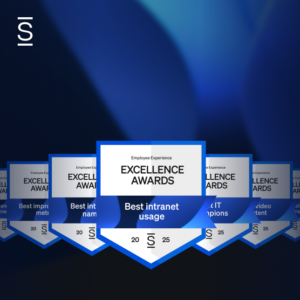Congratulations on launching your modern intranet! In this series of posts we’ll share how to make your intranet a sustainable success by driving user adoption, ensuring an uptick in visitors and growth in the number of employees using social features, as well as guaranteeing a great pipeline of content and delivering improvements and additional features that your users will love.
Moving your intranet forward takes time, effort and resources. The good news is that there’s now a body of best practice of critical steps, approaches, tactics, tips and tricks that intranet teams use to make their intranets better and better. In this post we’ll focus on team and process – here’s the first seven steps to your intranet success!

1. Establish sponsorship and ownership
Like any important system or platform in a company, you need to have a business sponsor or owner of your social intranet. This person should have recognizable influence in the organization and believe passionately in the power of the platform. They’re likely the one who will make the business case for investment, clear roadblocks, promote new initiatives and generally fight in your corner.
As well as an owner or sponsor, you may also need to involve senior stakeholders from other parts of your organization. Underneath this level, there is also likely to be a cross-functional team that meets regularly to discuss operational issues, such as new content areas and features.
2. Build a great intranet team
An important ingredient for your successful social intranet involves having an intranet manager responsible for executing the intranet strategy and ensuring the smooth day-to-day management of the channel.
Your intranet manager is likely to need an extended, ‘outer-ring’ intranet team that takes on a number of different support activities. These include IT development, search, training, content management, community management, internal communications, image production and so forth. The intranet manager plays a coordinating role across this network of individuals.
A key part of the extended intranet team will be the individual owners of the sites and communities within your social intranet. As well an owner, each site or community group will have an administrator or manager who coordinates most of the day-to-day activity. Make sure that all the activities associated with the intranet and all the different areas have designated individuals who understand their responsibilities.
3. Define processes, standards and policies

Once you’ve got the right people in place, you need to define the rules, policies and guidelines so that your social intranet operates to its full potential.
These rules don’t need to be heavy-handed or bureaucratic – this is more about establishing clarity than enforcing lockdown. Ultimately, rules and guidelines are there to help and support the employees who use the social tools and the site owners who manage their own areas.
Depending on the capability of your intranet, aspects you will need to cover include:
- Usage policy for social media
- Branding guidelines for content, look and feel
- Roles and responsibilities
- Processes for requesting new sites and groups
- Processes for requesting new features on the intranet
- Archiving and reviewing content
- Decision paths for disagreements
4. Focus on areas of business value
Leadership communications is one area where social intranets can add real value. Not only can you use your intranet to deliver messages from your CEO about important matters within the company, you can then get feedback from employees.
Getting your senior leaders to communicate through social tools such as blogs, status updates and commenting turns communication into dialogue. This creates engagement with employees and also provides valuable insight for senior management about employee sentiment.
Typical leadership communications that intranet teams have found successful include CEO blogs, “ask me anything” sessions and video broadcasts.
5. Focus on HR
An HR section of your intranet will be one of the key areas employees will use for reference, and it’s a great way to make the intranet essential and drive adoption. For example, making your intranet the place employees go to view their electronic pay stubs is a great way to increase your number of visitors.
HR intranets also drive efficiency. Most HR functions will want to encourage ‘employee self-service’ by posting intranet content that helps employees find the information they need or encourages them to use HR systems. This saves HR countless hours spent answering questions or carrying out basic transactions.
6. Champion the employee directory
Your employee directory is a central component that not only encourages networking and helps employees find experts, it also includes important information about each individual on their profile.

Profile information generally falls into three categories:
- Contact and role information, usually sourced from the HR system via Active Directory
- Rich biographical details completed by the individual
- Interactions and contributions on the intranet itself that are automatically generated
The richer the biographical data on the profile, the better! This part of the employee profile allows your workforce to get to know each other better and form a more rounded view of each other. It also allows you to find people with similar interests and backgrounds.
Focus on getting employees to complete their profiles. Sometimes responsibility for this needs to be cascaded through managers within different groups. Other intranet teams have tried different tactics, such as making profile completion part of the company orientation process or even making a contribution to a charity for each profile completed.
7. Use the social intranet for process improvements
Social intranets are not just about increasing employee engagement or creating a more unified culture. These systems can make a major contribution to improving processes and can result in many tangible benefits.
By allowing employees to collaborate and connect using social tools, there are often efficiency gains to be made, especially where email was the previous primary method of communication.
Typical processes that can be made more efficient using social tools include:
- Locating experts around the business and getting quick answers
- Coordinating responses to customer queries among frontline staff
- Collaborating on bids and tenders
- Learning and training, especially when blended with more structured approaches
- Ideation schemes that encourage ideas from employees and can generate millions of dollars in savings
- Orienting new hires and getting to know new colleagues
- Providing peer-to-peer support for IT systems to complement standard help desk support
Nine steps to deeper engagement
Once you have these seven key components running smoothly, you’ll be on your way towards making your intranet part of your company culture. Read our next blog in our Social Intranet Adoption Best Practices Part 2 of 3: 9 Steps to Improve Your Social Intranet















